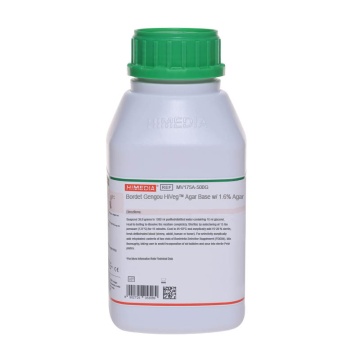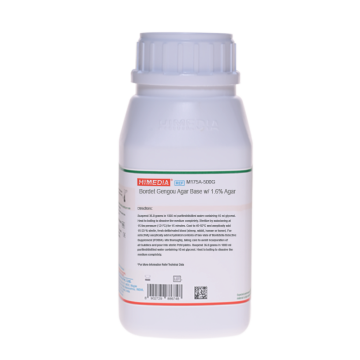 Your enquiry has been submitted
Your enquiry has been submitted
Bordet Gengou Agar Base
Bordetella#CC293D
Intended use
Recommended for detection and isolation of Bordetella pertussis and Bordetella parapertussis.
Composition**
| Ingredients | g / L |
|---|---|
| Potato infusion from 125g | 4.500 |
| Peptone | 10.000 |
| Sodium chloride | 5.500 |
| Agar | 20.000 |
Final pH ( at 25°C) 6.7±0.2
**Formula adjusted, standardized to suit performance parameters
Directions
Suspend 40.0 grams in 1000 ml purified/distilled water containing 10 ml glycerol. Heat to boiling to dissolve the medium completely. Sterilize by autoclaving at 15 lbs pressure (121°C) for 15 minutes. Cool to 45-50°C and aseptically add 15-20 % sterile, fresh defibrinated blood (sheep, rabbit, human or horse). For selectivity aseptically add rehydrated contents of 2 vials of Bos Selective Supplement (FD004). Mix thoroughly, taking care to avoid incorporation of air bubbles and pour into sterile Petri plates.
Principle And Interpretation
Bordet Gengou Agar Media were originally formulated by Bordet and Gengou (1) for cultivation of Bordetella species. Bordetella pertussis is the causative agent of whooping cough and with the help of cough-plate technique, B. pertussis can be isolated from pharyngeal extracts, nasopharyngeal secretions and pre-nasal swabs. Kendrick and Eldering (2) modified the original media by replacing 50% human or rabbit blood with 15% sheep blood to make the medium more enriched for detection of B.pertussis by the virtue of its haemolytic reaction. Enrichment of the basal media with 25% human blood aids in the detection of Mycobacterium species from small sputum inocula and in Streptomycin sensitivity testing (3).
The medium is highly nutritious thus supports luxuriant growth of Bordetella species and can also be used for mass cultivation of B.pertussis for vaccine production (4) and for maintaining stock cultures (1).
Potato infusion and peptone serve as carbon and nitrogen source, amino acids while glycerol and blood enrichment provides additional nutrients. Sodium chloride maintains osmotic equilibrium. Incubation should be carried out in a moist chamber (60% humidity) at 37°C for upto 7 days. Medium should not be over dried before use. After 40 hours B.pertussis colonies appear smooth, raised, glistening with a zone of haemolysis. Some strains of Bordetella are not haemolytic. For confirmation, serodiagnosis and biochemical test should be performed. This medium can be made more selective for Bordetella, by using antibiotics like penicillin (5), methicillin (4), cephalexin (2) of which, cephalexin was found to be superior. Cephalexin suppresses unwanted nasopharyngeal growth and significantly increases the isolation rate of Bordetella species. Cephalexin is used at a concentration of 40 mg/liter (FD004). Amphotericin B (10 µg/ml) can be added as an antifungal agent to the medium.
For isolation of B.pertussis from specimens, use standard procedures. Incubate the plates in a moist chamber at 35-37°C for 7 days and examine daily with or without dissecting microscope (oblique illumination) to detect the presence of B. pertussis. Sometimes the accompanying mold colonies can mask the B.pertussis colonies. Use sterile scalpel or needle to remove the portion of the agar that contains spreading colonies of moulds. B.pertussis colonies may not be visible without the aid of a microscope for 2-4 days. After 7 days of incubation plates may be discarded as negative. Some Haemophilus species will grow on Bordetella isolation media and cross-react with B.pertussis antisera. It may be prudent to rule out X and V factor dependence.
Type of specimen
Clinical samples -Pharyngeal extracts, nasopharyngeal secretions and pre-nasal swabs.
Specimen Collection and Handling
For clinical samples follow appropriate techniques for handling specimens as per established guidelines (7,8). After use, contaminated materials must be sterilized by autoclaving before discarding.
Warning and Precautions
In Vitro diagnostic use. For professional use only. Read the label before opening the container. Wear protective gloves/protective clothing/eye protection/ face protection. Follow good microbiological lab practices while handling specimens and culture. Standard precautions as per established guidelines should be followed while handling clinical specimens. Safety guidelines may be referred in individual safety data sheets.
Limitations
- Some Haemophilus species will grow on Bordetella isolation media and cross-react with B. pertussis antisera.
- B. pertussis colonies may not be visible without the aid of a microscope for 2-4 days.
Performance and Evaluation
Performance of the medium is expected when used as per the direction on the label within the expiry period when stored at recommended temperature.
Quality Control
Appearance Cream to yellow homogeneous free flowing powder.
Gelling Firm, comparable with 2.0% agar gel.
Colour and Clarity of prepared medium Basal Medium : Light yellow coloured clear to slightly opalescent gel. After addition of glycerol and 15% v/v sterile defibrinated blood: Cherry red coloured opaque gel forms in Petri plates.
Reaction Reaction of 4% w/v aqueous solution at 25°C. pH : 6.7±0.2
pH 6.50-6.90
Cultural Response Cultural characteristics observed with added Glycerol and 15% v/v sterile defibrinated blood and Bos Selective Supplement (FD004), after an incubation at 35-37°C for 3-4 days.
| Organism | Inoculum (CFU) | Growth | Recovery | Haemolysis |
|---|---|---|---|---|
| Bordetella bronchiseptica ATCC 4617 | 50-100 | good-luxuriant | >=50% | gamma |
| Bordetella parapertussis ATCC 15311 | 50-100 | good-luxuriant | >=50% | gamma |
| Bordetella pertussis ATCC 8467 | 50-100 | good-luxuriant | >=50% | beta |
| Staphylococcus aureus subsp.aureus ATCC 25923 (00034*) | >=10^4 | inhibited | 0% |
Key : (*) Corresponding WDCM numbers.
Storage and Shelf Life
Store between 10-30°C in a tightly closed container and the prepared medium at 2-8°C. Use before expiry date on the label. On opening, product should be properly stored dry, after tightly capping the bottle in order to prevent lump formation due to the hygroscopic nature of the product. Improper storage of the product may lead to lump formation. Store in dry ventilated area protected from extremes of temperature and sources of ignition. Seal the container tightly after use. Product performance is best if used within stated expiry period.
Disposal
User must ensure safe disposal by autoclaving and/or incineration of used or unusable preparations of this product. Follow established laboratory procedures in disposing of infectious materials and material that comes into contact with clinical sample must be decontaminated and disposed of in accordance with current laboratory techniques (7,8).
Reference
- Bordet and Gengou, 1906, Ann. Inst. Pasteur, 20:731.
- Kendrick and Eldering, 1934, Am. J. Public Health, 24:309
- Tarshis M. S. and Frisch A. W., 1951, Am. J. Clin. Pathol., 21:101.
- Broome C. V., Fraser D. W. and English J. W., 1979, Internat. Symp. on Pertussis, DHEW, Washington, D.C., 19.
- Flemming A., 1932, J. Path. Bacteriol., 35:831.
- Isenberg, H.D. Clinical Microbiology Procedures Handbook 2nd Edition.
- Jorgensen, J.H., Pfaller, M.A., Carroll, K.C., Funke, G., Landry, M.L., Richter, S.S and Warnock., D.W.(2015) Manual of Clinical Microbiology, 11th Edition. Vol. 1.
| Product Name | Bordet Gengou Agar Base |
|---|---|
| SKU | M175 |
| Product Type | Regular |
| Physical Form | Powder |
| Origin | Animal |
| Packaging type | HDPE |
| References | 1. Bordet and Gengou, 1906, Ann. Inst. Pasteur, 20:731. 2.Kendrick and Eldering, 1934, Am. J. Public Health, 24:309 3.Tarshis M. S. and Frisch A. W., 1951, Am. J. Clin. Pathol., 21:101. 4.Flemming A., 1932, J. Path. Bacteriol., 35:831. 5.Broome C. V., Fraser D. W. and English J. W., 1979, Internat. Symp. on Pertussis, DHEW, Washington, D.C., 19. 6.Suitcliffe E. M. and Abbott J. D., 1972, B. M. J., iii:732. |
| Customized Product Available | No |










